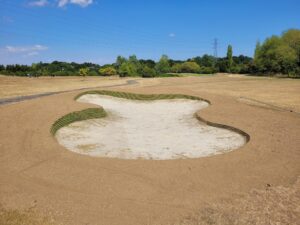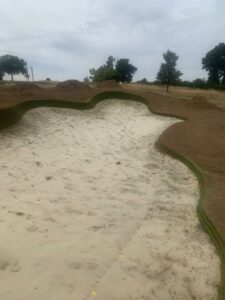“The members are absolutely over the moon”
Related Articles
Roy Carter, course manager at The Rayleigh Club in Essex, talks about the challenges of irrigating the course during this summer’s drought and carrying out a radical and stunning transformation of the bunkers.
When Roy Carter was asked to step into the course manager role at The Rayleigh Club in Essex by the club’s owner, Jamie Saitch, he jumped at the chance to help fulfil Jamie’s ambition of making the club into one of the leading golf resorts in the south east of England. We caught up with Roy to find out about the club’s plans to overhaul the current irrigation system, the effect of this year’s drought conditions on the course and working with Durabunker to complete a radical and surprising transformation of the bunkers.
Could you tell us about your background and how you became the course manager at The Rayleigh Club?
I was initially asked to do some construction work on the course by Jamie Saitch, who’s my best mate. My background is in construction on golf courses, mainly in digger work, shaping tees and bunkers and so on. I was also a mechanic when I left school and I’m mechanically minded which also helps. Jamie asked me to take on the course manager role nearly four years ago because we both want the club to be the best it can be. We’ve got a team of 10, including myself. It’s not a huge team considering the size of the grounds we’ve got to maintain but we get there. Jamie trusts that he can leave us to get things done but we can also approach him at any time if we need anything and he’s full of good ideas and has a vision for the future so it’s a lovely job and place to work.
What makes the courses stand out and what are the trickiest aspects for your team to maintain?
We’ve got two 18-hole courses, the South Course and the East Course, and a driving range. The South Course is membership only and The East Course is open to the public. When Jamie first bought the club he put £1,000,000-worth of drainage into the South Course, so it’s open virtually all winter when it used to have to close for up to three months. He also made sure there was a lot of car park space and infrastructure for golf buggies so they can be used in winter too. Jamie is especially concerned that our more elderly golfers can get around safely and he’s really invested in the club since he bought it.
The trickiest aspect at the moment is keeping the irrigation going. In this very hot dry weather we’ve had blowouts on pipes and popups and it’s been a lot of work to stay on top of it. Luckily Jamie’s the type of owner who listens to what we need and sorts any equipment or machinery out quickly, so we don’t find things too difficult.
How much extra work are you and your team having to do to protect the courses during the drought conditions you’re experiencing in Essex at the moment?
We’re doing a lot of hand watering every day with the two bowsers we’ve bought recently. We’re probably using about 14,000-15,000 litres of water a day. The greens are looking like little oases out there at the moment so we’re holding up pretty well but looking forward to the rain.
Are you noticing evidence of climate change in general and how much does it affect your day-to-day work?
It’s massively affecting us every day, especially when it comes to irrigation. We’re hoping to install a new irrigation system next year, which will help a lot. The current one is getting old. Our water doesn’t run off mains pressure, it runs off lakes and we rely on them filling up in the winter so we’ve got storage for the summer. If the lakes are dry we’re in trouble. We’re looking to get a test borehole done and we’ve got a team working on plans for that now. We need to be ahead of the game.
What do you enjoy most about your job and what has been your biggest challenge to date?
It’s different every day and it’s a challenge every day but we achieve a lot. There are no boring days. We’ve got great members and the boys I work with are fantastic and very dedicated. It’s great for me.
Keeping up with irrigation is the biggest challenge for us. 2023 will be the year we focus on irrigation and replacing the old system while finding new water sources. We enjoy finding solutions to problems as a team and I’m positive we can make big improvements.
Durabunker has recently done a full course redesign and build on the South Course. What problems were you facing with your bunkers beforehand and how has Durabunker made a difference?
We had problems with waterlogging in the bunkers and lots of them were built into the slopes so could get slippery. The course is about 30 years old and the bunkers really needed a complete overhaul, they were a mess. Jamie and myself didn’t want the new ones to look like normal, run-of-the-mill bunkers like everywhere else you play. So between us we went around and decided on a variety of bunkers; pot bunkers, American-style bunkers and hybrids of the two. We wanted the bunkers to be a real feature. When we spoke to Rhydian Lewis, the managing director of Durabunker, and told him about our concept he understood it straight away, even though it’s quite different from what other clubs have done. We were all on the same wavelength from day one and the whole process has felt like a collaboration. This project has mainly been about greenside bunkers but we’ve been so pleased with what Durabunker have done we’ve asked them to come back next year and do the same with the bunkers on the fairways. It’s all about making the course the best of its kind in the area and I really think we’re getting there.
Was the installation process straightforward?
It’s a big job but Durabunker have done everything we’ve asked of them. The project has gone to plan and even ahead of schedule and there’s been minimal disruption. Everything is ready for seeding and watering now and we’ll do that as soon as the very hot, dry weather ends. Once the grass has grown and it’s all been cut the bunkers are going to look stunning and they’re very low maintenance so my team will have more time to focus on other things. It’s a win-win situation for everyone. The whole Durabunker team has put in 100 percent and we can’t wait to have them back again.
Have you had any feedback about the bunker transformation from the members?
The members are absolutely over the moon about them. They didn’t mind the little bit of disruption because they could see what they were getting at the end of the day and they knew how much it was going to improve the course for them. They feel like they’re being looked after. It’s been exciting for everyone and the feedback so far has been overwhelming. It’s Jamie’s dream as a golfer himself to make the course a great course for other golfers and, as the sole proprietor, the investment all comes from him. The course has taken a huge step forward with the new bunkers. Durabunker have smashed it out of the park!
What advice would you give to anyone hoping to follow the same career path as you?
It’s hard work and you’ve got to get your head down. You need to do it for the love of the job because there isn’t a lot of money in it. Despite that job satisfaction is very high in greenkeeping and that’s the main thing, I think. It’s important to be able to come into work happy in the morning and enjoy what you do and if you can’t do that you should try to find something else. Being able to stand back at the end of the day and look at beautiful greens or perfect bunkers is why people love this job. Some people think you can just sit anyone on a mower and they’ll be able to cut the golf course and it just isn’t like that. It’s so much more highly skilled than most people realise and you need a lot of knowledge in a lot of areas.
80 bunkers were built or filled this summer
51 bunkers built, 29 bunkers filled, significant mounding removed, pathways diverted and all work areas prepared for seeding in nine weeks? Sounds a big ask, but one which was achieved by the team from Durabunker this summer, at The Rayleigh Club.
The project was brought to life after Durabunker owner, Rhydian Lewis, was introduced to club owner Jamie Saitch and Course Manager Roy Carter by Andy Law of Whitemoss Eco.
“It was evident to us that the owner was incredibly passionate about the golf course, he had a clear idea of the style of bunker he wanted, being a lover of links golf, but the dialogue and design ideas we put forward eventually led us to more of a hybrid design style, inspired by the marshland feel of the course,” said Lewis. “We based our design around combining deeper irregular shaped revetted walls with shallower revetted sand flashed faces so that there was a hybrid of two styles, which is unusual but not unprecedented. We previously worked with Dye Design where we saw this combination of design styles for the first time and it looked surprisingly effective.”
The project combined Durabunker’s synthetic bunker edge product and Bunkermat bunker liner, with Durabunker responsible for all design and construction work.
“Combining our patented synthetic bunker edging with a high quality liner and coupling that with maintenance friendly design is a greenkeeper’s dream,” added Lewis. “Head greenkeeper Roy and I had a few discussions about how far we could push the shaping, Roy understandably having ease of maintenance as number one priority, whilst the owner wanted more the ‘wow factor’, so we had to strike a balance. We literally agreed, for example, the exact number of bunker noses that Roy would be happy fly-mowing and we ended at a number of six out of a total of 51 bunkers. This enabled us to create some really eye-catching signature bunkers whilst still reducing bunker maintenance significantly and transforming the look of the bunkering.”
Jamie Saitch, owner at The Rayleigh, commented: “Durabunker staff have been outstanding not just with the quality of the work but also their attitudes and respect for the club, clubhouse, the members and the course. The work is first class and the look and feel of the course is exactly like I envisioned when we first met. They should be very proud of everyone associated with the company that has worked to transform The Rayleigh Club into what will become one of the best courses in Essex, if not the south east.”






























